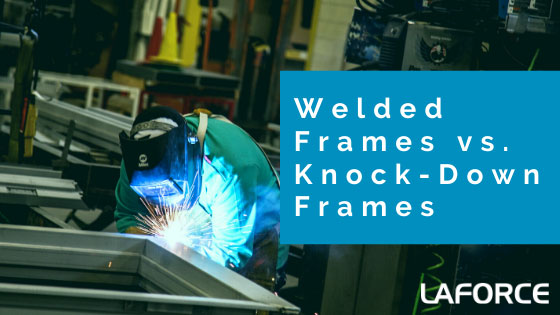LaForce sells two main types of hollow metal frames: “welded” and “knock-down.” These frames have similar components (such as hinge jambs, strike jambs, heads, and anchors) yet unique applications and installation methods.
Definitions of industry terminology used throughout this article can be found here: Door, Frame, and Hardware Glossary.
Welded Frames
Welded frames are assembled at the factory. Jambs are squared to the head, face and rabbet joints are welded, and all exposed weld marks are ground smooth. A spreader bar is tack-welded at the bottom of the frame for shipping purposes.
Application and Installation
This type of frame is used in interior stud walls, masonry block walls, and cast-in-place or pre-cast concrete walls.
When using welded frames in interior stud walls, they are installed prior to the construction of the wall. Frames are set in the correct locations with studs and drywall built around them. Welded frames are secured to the studs with screws or ties through either snap-in or welded anchors. At the bottom of each frame is a base anchor.
When installing welded frames into new masonry block walls, the frame is once again set prior to laying the wall. “T” anchors or masonry wire anchors are laid between every few rows of block to secure the frame to the wall.
In instances where a welded frame must be installed into an existing block wall, the frame must be dimpled for an existing wall anchor (EWA). The frame is then slid into the existing opening, holes are drilled into the existing block wall through the dimples, and expansion bolts are screwed into place.
Knock-Down Frames
Knock-down frames are not assembled in the factory. They are sent as separate jamb and head pieces for assembly in the field by the installers.
Applications and Installation
Knock-down frames – also known as after-set drywall frames – are meant to be installed after the stud wall has been built and drywall applied. This type of frame comes in three pieces: the hinge jamb, the strike jamb, and the head. The frame head is installed first. Then each jamb is inserted into place and aligned to the head with tabs and slots. Once all pieces are applied onto the wall, a wood spreader is used to assist securing the base anchors.
Knock-down drywall type frames can be supplied with either a strap-style base anchor that gets notched into the drywall or a dimple on the face of the jamb bottom that allows a screw to be fastened into the stud. The jambs are then plumbed by adjusting compression anchors near the head of the frame. This will tighten the frame head against the jambs, completing the installation process.
We hope this answered your query! If you are stumped by another door, frame, or hardware question, please reference our blog archive, free glossary, or contact a LaForce representative.



Follow Us